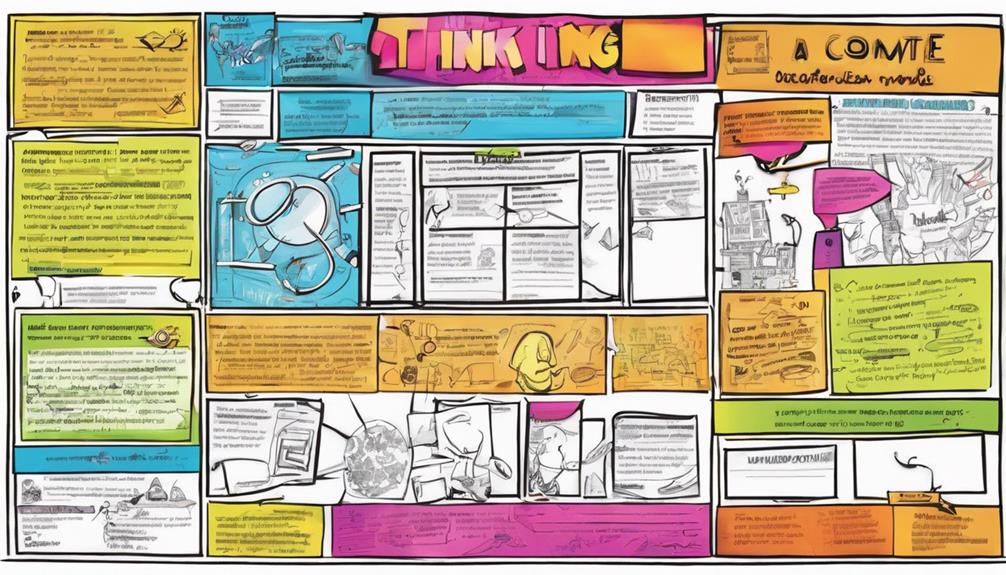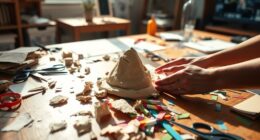One of the main tools associated with design thinking is the Empathy Map. It helps you understand user perspectives deeply and create emotionally meaningful solutions. By exploring user emotions, behaviors, and motivations, teams can drive informed design decisions and develop user-centric solutions. Using Empathy Maps fosters a human-centered approach to problem-solving, ensuring successful design outcomes. Embrace an empathetic approach through Empathy Maps to put the user at the center of the design process. Understanding user needs and enhancing user experiences are essential for achieving design thinking success. Further insights await on how Empathy Maps enrich the Design Thinking process.
Key Takeaways
- Empathy Maps are essential tools in Design Thinking.
- They help understand user perspectives deeply.
- Facilitate shared understanding among team members.
- Drive informed design decisions.
- Ensure user-centric solutions by focusing on user needs.
The Power of Design Thinking
Explore the transformative power of design thinking in problem-solving and innovation. Design thinking is a user-centered approach that emphasizes understanding user needs and challenges.
One vital tool within this methodology is the Empathy Map. By utilizing Empathy Maps, teams can gain a deep understanding of user perspectives, including their emotions, behaviors, and communication styles. These tools facilitate the development of a shared understanding among team members, enabling them to make informed design decisions.
Empathy Maps play an important role in creating emotionally meaningful solutions that resonate with users. By capturing user emotions and thought processes, teams can design products and services that address user needs effectively. This user-centric approach ensures that design solutions aren't only functional but also emotionally impactful.
Through the design thinking methodology, teams can leverage Empathy Maps to craft innovative solutions that truly connect with their target audience.
Key Components of an Empathy Map

Understanding the key components of an Empathy Map is necessary for gaining insights into user perspectives in design thinking.
An Empathy Map consists of four vital elements: 'Think and Feel', 'See', 'Say and Do', and 'Hear'.
The 'Think and Feel' component explores user emotions and motivations, offering a deeper insight into what drives their actions.
'See' focuses on the user's physical environment and interactions, providing context to their experiences.
'Say and Do' captures the user's communication style and behaviors, shedding light on how they express themselves.
By analyzing these components, designers can empathize with users, fostering a human-centered approach to problem-solving.
Empathy Maps are valuable tools that help visualize user perspectives, guiding the creation of solutions that truly meet user needs.
Incorporating these key elements enables a more thorough understanding of user needs and preferences, ultimately leading to more effective and empathetic design outcomes.
Using Empathy Maps in Design Thinking

To effectively apply Empathy Maps in design thinking, begin by identifying user needs, thoughts, feelings, and behaviors through the key components of 'Think and Feel', 'See', 'Say and Do', and 'Pain Points'.
Empathy Maps are instrumental in fostering a shared understanding among team members, enabling them to collect, organize, and visualize user information. By utilizing these components, teams can drive informed design decisions that lead to the creation of emotionally meaningful solutions that resonate with users.
Understanding what users think and feel, what they see, what they say and do, and their pain points is vital in developing products or services that truly meet their needs.
When teams deeply empathize with users through Empathy Maps, they're better equipped to design products that address real user concerns and desires, ultimately leading to more successful outcomes in the design thinking process.
Design Thinking Measure of Success

A key indicator of success in Design Thinking lies in how effectively your solution addresses user needs and pain points. User satisfaction levels play a pivotal role in determining the success of your design, reflecting how well the solution resonates with users.
The impact on user experience is another crucial measure of success, showcasing how the solution enhances the overall user journey. Additionally, innovation and creativity within the solution are essential aspects to take into account when evaluating success in Design Thinking.
Ensuring alignment with business goals is vital, as it guarantees that the solution meets strategic objectives and delivers value to the organization. By focusing on user needs, pain points, solution effectiveness, user journey enhancement, and strategic objectives, you can effectively measure the success of your Design Thinking process.
Keep these factors in mind to create impactful and relevant solutions that truly benefit both users and the business.
Tools for Design Thinking Process

In the domain of Design Thinking, utilizing empathy maps is important for visualizing and understanding user needs. These tools associated with Design Thinking enable designers to explore the user's world, capturing their thoughts, feelings, and behaviors to craft solutions that resonate emotionally.
By adopting an empathetic approach through empathy maps, designers can tailor User Experience solutions that address real user needs effectively. Empathy maps aid in creating personas that represent different user segments, guiding the design process towards human-centered solutions.
Teams benefit from using empathy maps as they foster shared understanding and empathy within the team, aligning everyone towards a common goal of creating impactful solutions.
Ultimately, empathy maps play an essential role in enhancing the Design Thinking process by putting the user at the center of the design journey, leading to more meaningful and successful outcomes.
Frequently Asked Questions
What Is One of the Tools Associated With Design Thinking in SAFE Agile?
When working in SAFe Agile, you'll find the Portfolio Canvas to be a valuable tool. It helps you visualize and align strategic themes, business outcomes, and value streams for effective decision-making and successful portfolio management.
What Are the Tools Used in Design Thinking?
In design thinking, you use various tools to innovate and solve problems creatively. These tools include empathy maps, user personas, journey maps, brainstorming sessions, prototyping, and user testing. Each tool helps you understand users better and design solutions effectively.
What Are the Analytical Tools of Design Thinking?
When considering analytical tools in design thinking, you should explore the Empathy Map. This tool visualizes user needs and behaviors, promoting empathy and shared understanding. It informs design decisions and aids in generating innovative ideas.
What Is One of the Powerful Tool to Ideate During Design Thinking Process?
When ideating in design thinking, one powerful tool stands out—brainstorming. It sparks creativity, fosters collaboration, and reveals innovative solutions. By encouraging diverse perspectives and rapid idea generation, brainstorming fuels the creative process and addresses user needs effectively.
Conclusion
To sum up, one of the tools associated with design thinking is the empathy map.
Like a compass guiding you through uncharted waters, the empathy map helps you navigate the complex landscape of human emotions and experiences.
By understanding the needs and perspectives of others, you can create innovative solutions that truly make a difference.
So, grab your empathy map and set sail on the creative journey of design thinking!









